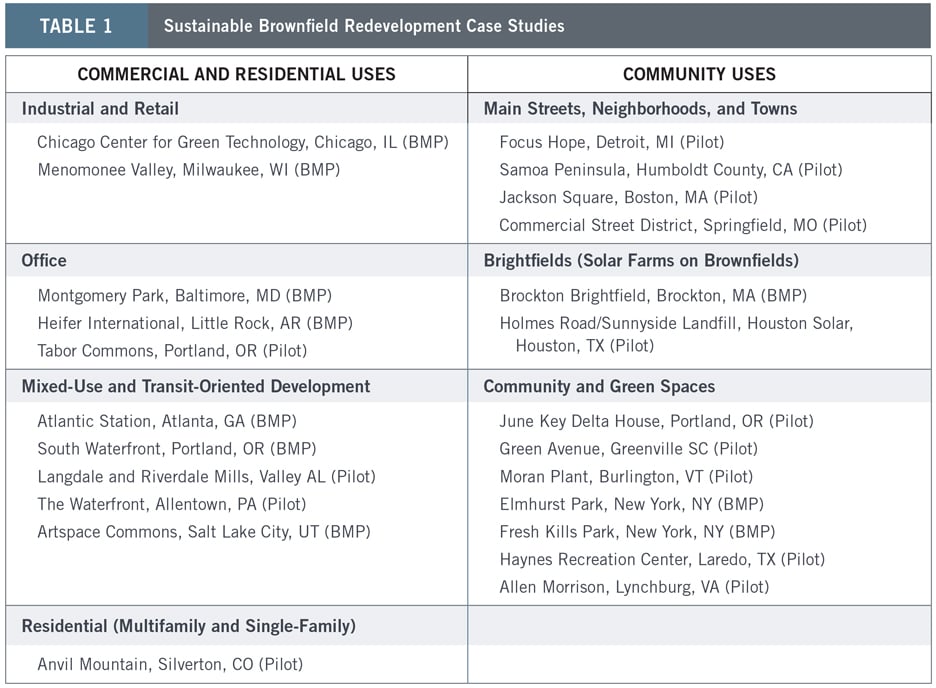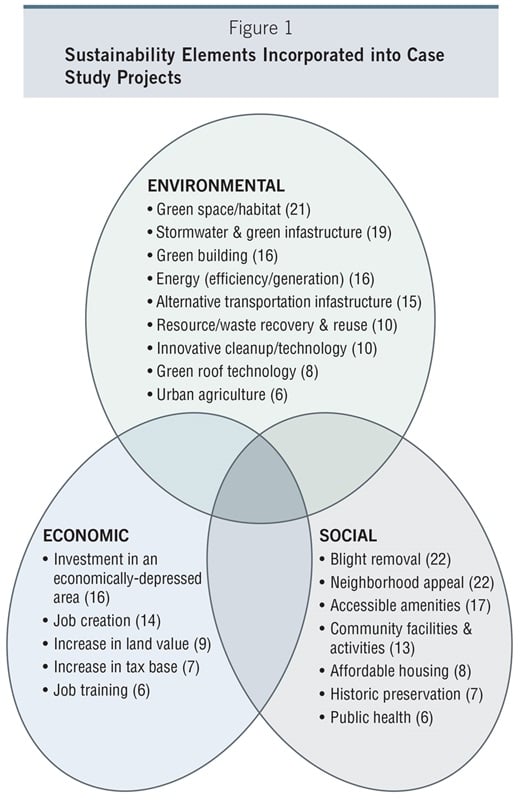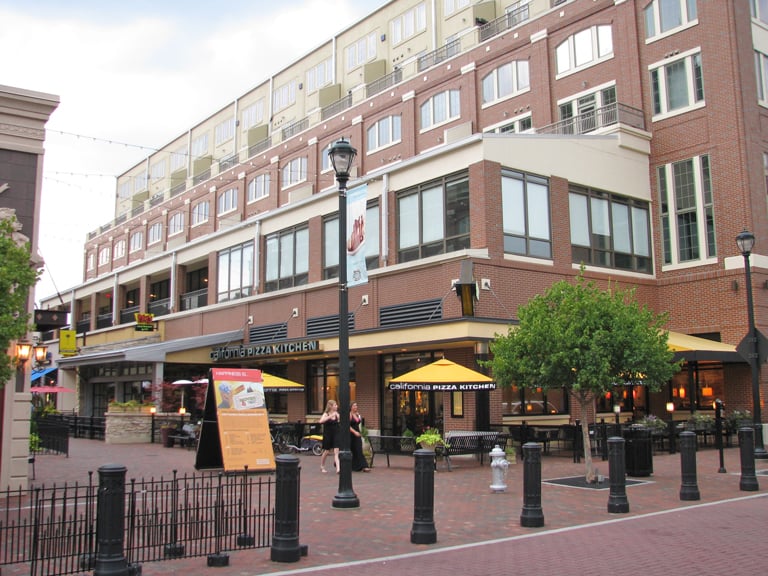
Sustainable Brownfield Redevelopment
Release Date: September 2022
Former industrial sites and other properties that may be contaminated — commonly called brownfields — can be found across the United States and Canada. Brownfields are often adjacent to well-developed transportation infrastructure, and many are near urban centers. These locational advantages make many brownfields viable targets for redevelopment to new uses, but the costs and risks associated with environmental remediation often make these redevelopment projects impossible without public financial and regulatory support. For this reason, public-private partnerships involving multiple levels of government, nonprofit organizations and private developers have played a prominent role in brownfield redevelopment. Public support for these projects has long been tied to achieving social and economic goals such as increasing employment, revitalizing communities and strengthening local real estate markets. In recent decades, public-private partnerships have also prioritized environmental objectives, from green building design to renewable energy and ecological revitalization.
Social, economic and environmental sustainability are now key considerations for most brownfield redevelopment projects backed by public-private partnerships. Even developers who pursue brownfield projects without public subsidies may find it beneficial or necessary to pursue sustainability objectives to obtain necessary entitlements and community support.
The NAIOP Research Foundation commissioned this research brief to offer insights into the key considerations that guide sustainable brownfield redevelopment. In 2009, with support from the U.S. Environmental Protection Agency (EPA), the author of this brief initiated a research project to study more than two dozen brownfield redevelopment projects across the U.S. Ten of these were already considered sustainability trailblazers and Best Management Practices (BMP) in the brownfields arena, and 14 others were granted seed funding by the EPA to incorporate sustainability as part of a Sustainable Brownfields Pilot program. He followed the progression of these projects for more than a decade and published the findings in Sustainable Brownfield Development: Building a Sustainable Future on Sites of our Polluting Past, on which this research brief is based. Lessons learned from these projects offer developers guidance on how they can partner with the public and nonprofit sectors to explore, realize and advance a more sustainable future.

Heifer International Headquarters, Little Rock, Arkansas.
What is Sustainable Brownfield Redevelopment?
Priorities, Realities and Lessons
Brownfield redevelopment has its origins in the late 1970s, when the EPA took a lead role in addressing hazardous waste and site contamination. In 1980, Congress passed the Comprehensive Environmental Response, Compensation, and Liability Act (aka Superfund) to tax polluting industries and allow the federal government to respond directly to releases or threatened releases of hazardous substances. As communities and regulators became more concerned about environmental hazards, landowners, developers and investors became more uncertain about what to do with these properties. The Fleet Factors court decision of 1990, which found banks liable for environmental cleanup on a foreclosed property, had a particularly chilling effect on the flow of investment to former industrial and commercial sites. As scientists and regulators worked to understand the risks of contamination, the number of known and potentially contaminated properties sitting underused, idled and abandoned reached the hundreds of thousands by the early 1990s as deindustrialization increased the inventory.
In the early 1990s, the federal government began an essential shift from an enforcement-driven regulator of environmental risk to a facilitator of remediation, reuse and smarter growth. The EPA brought together federal agencies with different priorities, state and local governments, and stakeholders from the private and nonprofit sectors. Potentially contaminated sites were re-branded as “brownfields.” While managing site risk remained a priority, sustainable land-use goals associated with recycling land, removing blight, restoring employment, revitalizing communities and strengthening the urban real estate market also became critical factors motivating public, private and community partners. In 2002, Congress enacted the Small Business Liability Relief and Brownfields Revitalization Act to codify proven practices, policies and guidance. Federal initiatives were supported by state voluntary cleanup/response programs that offered flexible cleanup options, liability protections, funding and more leeway for private developers to work on marketable projects voluntarily.
Sustainability objectives have always been central to the U.S. government’s environmental mission. Its efforts encourage and facilitate sustainable brownfield redevelopment through education, technical assistance and funding.1 States also have an interest in incorporating sustainability in cleanup and end-use decisions through voluntary cleanup/response programs. However, they continue to focus on guiding all projects through the assessment and remediation process and on providing financial incentives to all eligible projects and entities. Local governments often mandate green building and other sustainability elements for publicly supported projects, including brownfields, with more contemplating such standards for all new development. While little has changed thus far for private developers of brownfields in terms of costs, risks and approaches, new government and community priorities, regulations and incentives regarding sustainability are likely on the horizon. This will affect developers engaged in these projects and how they approach them.
What have early adopters of sustainable brownfield redevelopment experienced, and what lessons can they provide? The table below lists the two dozen early Best Management Practice (BMP) and Sustainable Brownfields Pilot-funded case study projects.

The main findings and lessons from the case studies are summarized here.
Identifying and Prioritizing Project Objectives
The case studies reveal that conventional concerns guide brownfield redevelopment projects supported by public-private partnerships. Stimulating local development through blight removal, new construction, adaptive reuse and greening remains the primary objective of sustainable brownfield projects. Sustainability, green building and environmental justice considerations, while important, were secondary objectives for most projects. Public leadership and support were essential for advancing sustainability in virtually all cases examined. In most BMPs led by private and public partners, sustainability was a response to a government objective (e.g., Chicago Center for Green Technology, Brockton Brightfield) or a government requirement (South Waterfront, Atlantic Station), while for some BMPs and most Pilots, sustainability ideas were seeded early on by government incentives (e.g., EPA funds to the Pilots, Menomonee Valley). Early visioning activities were crucial to identify and address the objectives of multiple stakeholders and community members and to form a broad coalition that supported these projects. That said, most project proponents were concerned early on about the barriers typically associated with brownfield projects (e.g., added costs, delays), with private sector partners expressing additional concern over the extra costs and the perceived loss of opportunity associated with adding sustainability and greening measures. Early identification of these concerns allowed partners in the public and private sectors to work through how to support brownfield and sustainability elements financially.
Location, Market and Reuse
Most of the case study projects were originally industrial parcels or commercial/retail sites, followed by a few landfills, offices and residential spaces. Many of these sites are not located in the downtown core but near it, in midtown locations or outside the central city. Projects in these markets may have more difficulty attracting tenants and investment, leading some to be delayed and others to change use. Sustainable redevelopment projects must be mindful of the market viability of planned new uses. Unless the proposed redevelopment is for a public use, the government needs to target its support to private and nonprofit projects that are economically and operationally viable to realize social, economic and environmental sustainability goals. The new uses in most sustainable brownfield redevelopments were comprised of office, retail, residential, mixed-use or public services associated with green space or community facilities. Greening was an aspect of virtually all case study projects, regardless of end use. Reindustrialization, however, was only a component of two projects: the Chicago Center for Green Technology, which subsequently lost its industrial tenant and is now solely office space; and the Menomonee Valley, which attracted manufacturers but rejected a proposed warehouse for its Menomonee Valley Industrial Center due to low job density. The latter exemplifies the difference between conventional brownfield redevelopment, which would support a warehouse distribution facility, versus sustainable brownfield redevelopment supported by public-private partnerships. Conventional warehouses and distribution centers may not support the job density needed to attract public subsidies in all jurisdictions.
Land Acquisition and Assembly
A key finding is the vital role that government, particularly at the local level, plays in land acquisition and the assembly of privately and publicly owned parcels for redevelopment. The total land area of the case study projects was just over 4,000 acres, with an average size of 182 acres and a median of 23.5 acres. Most brownfield sites were initially owned by private entities, with a few primarily under public ownership. While most were acquired via a willing sale, just under half of the acquisitions involved government interventions such as eminent domain or other arrangements. Even developers that acquire brownfield sites without public subsidies should be mindful of public desires for these sites, as some of the park projects examined resulted from adverse public reactions to commercial redevelopment proposals.
Site Preparation (Remediation, Building Rehab, Infrastructure)
While all brownfield redevelopment projects require environmental site assessment and may need remediation, other elements of site preparation — such as infrastructure, ecological enhancements and the demolition or adaptation of existing buildings — vary based on project objectives and scope. All the sustainable brownfield redevelopment projects that were studied went through voluntary cleanup programs in their respective states. The public sector played a leading role in overseeing, supporting and funding cleanup for many projects. In some cases, projects had to meet sustainability requirements to access public funding. In others, the EPA identified projects that received state and local cleanup funds as candidates for federal sustainability funding. Contamination management was relatively conventional, with many projects involving soil and material removal, capping and demolition. Sustainable/green remediation techniques such as material recovery and institutional controls were adopted by developers in a few projects to reduce waste and address pollution. However, more advanced greening techniques such as phytoremediation and bioremediation were not usually prioritized by developers, stakeholders or the general public. In larger projects, governments were involved in the remediation of public property while also supporting the cleanup of individual parcels as private or nonprofit partners redeveloped them. They also worked to make projects accessible by building roads and bridges for automobile and truck traffic, as well as bicycle and pedestrian infrastructure. Green infrastructure was also a common focus, bringing together stormwater management, ecological enhancement, aesthetic improvement, and public access and use. Half of the projects involved building restoration and adaptive reuse. While heritage value and aesthetics mattered for some projects (e.g., Montgomery Park, Langdale Mills), many of the reused buildings were not architecturally noteworthy and included former gas stations, office buildings and power facilities. However, the high cost of making structures safe for reuse and the high cost/low resale value of some deconstructed material often make demolition and disposal the only viable option.
Funding and Financing
Regardless of whether the projects were small or large, financial support from the public sector was vital for supporting sustainable brownfield redevelopment. This was particularly true for projects in peripheral or secondary markets where public and private partners hoped to clean up past blight, add new infrastructure, and trigger market and community revitalization. Developers in public-private partnerships must pursue and creatively assemble public funds from numerous sources to address the many cost barriers that impede both brownfield redevelopment and sustainability goals. Local governments in weaker markets must assume considerable financial responsibility to attract developers and advance brownfield projects, but they can also use this support to obtain environmental and social benefits. Since private developers respond to market demand and profit, the most effective government programs have been those that prioritize financial viability while also encouraging sustainability elements. Therefore, strong inter- and intra-governmental cooperation, public-private partnerships and non-profit partnerships will be vital for sustainable brownfield redevelopment efforts to succeed.
Planning and Construction
In planning sustainable projects, developers benefited from the support and technical expertise of the federal government, national/international consulting service firms, local universities and professional associations. Many of the larger, multiphase projects benefited from planning and design actions that established a comprehensive plan, a detailed roadmap for undertaking it, and, if broad in scope, a viable catalytic project to start it off. Plans worked best when they incorporated community input that was linked to an area-wide vision for the neighborhood and helped achieve multiple stakeholder and community objectives.
Figure 1 provides a visual summary of the sustainability-oriented features and elements these projects incorporated (with the number of projects in parentheses). These are displayed according to the three spheres of sustainability, followed by a brief discussion of key findings and lessons.

Environmental Sustainability
Most projects incorporated green space or habitat elements (21 case study projects out of 24 considered) and green infrastructure (e.g., stormwater management) (19). These were popular features because they provide a green aesthetic that erased past blight and attracted users while also performing ecological and environmental infrastructure functions. More than half included green building design (16); energy efficiency, conservation or generation features (16); and alternative transportation infrastructure for public transit, walking and cycling (15) aimed at alleviating costs and improving access. Less common green practices included resource/waste recovery and reuse, innovative cleanup/technology, green roofs and urban agriculture.
An important lesson from the cases is that sustainability and green design guidelines such as the LEED (Leadership in Energy and Environmental Design) rating system provided helpful direction for developers, although not all buildings were registered for certification due to cost. Other challenges to environmental innovation included the complexity or incompatibility of local policies and regulations with novel green construction techniques, the high cost of sustainable technology, difficulties incorporating green components into building design, and the complexity of non-planning factors such as procurement rules, jurisdictional issues and financing. Many developers emphasized the important role governments play in promoting and supporting green practices, although they also highlighted the need to make sure that regulations do not impede their implementation and that technical assistance and funding are available to support and propel the sustainability efforts to completion.
Social Sustainability
Most projects strove to contribute to community quality of life by removing blight (22 out of 24 considered), enhancing neighborhood appeal (22), and improving the availability and access to amenities (e.g., parks, trails, paths) (17) and community-oriented facilities and activities (e.g., community centers, educational workshops) (13). Less common social sustainability features included affordable housing, historical preservation and public health improvements. Community and quality-of-life interventions are generated with community involvement and tend to focus on improving aesthetics and providing community spaces and activities. Successfully advancing social sustainability requires a high degree of community involvement in project planning. Nonprofit organizations were particularly effective at undertaking activities that tackle complex social and environmental justice issues related to demographics (i.e., race, income, crime), housing and health. This can make them valuable participants in public-private partnerships.

Atlantic Station, a mixed-use development in Atlanta, Georgia.
Economic Sustainability
About two-thirds of the projects stressed investment in an economically depressed area (16) and job creation (14). Several projects focused on raising land values, increasing the local tax base or adding job training opportunities. Large projects, such as the Menomonee Valley in Milwaukee and South Waterfront in Portland, emphasized conventional tax-generation and employment-boosting proposals to help justify public investments through programs such as tax increment financing. They also aimed to link jobs to residents by improving site access (e.g., public transit, auto and bridge infrastructure) and through workforce development. Local communities often sought a range of economic outcomes from these projects that extended beyond job creation, including higher minimum wage levels, local employment and ownership, provisions for health insurance, job density, and local workforce training and development.
Economic value was usually the main justification for the public investments needed to overcome barriers to brownfield redevelopment. Nonetheless, in many cases, limited public financial and regulatory support constrained project outcomes, with over a third of projects noting limited funding for initiatives, a quarter reporting regulatory hurdles affecting access to funds, and a few stressing high contamination costs and low buyer demand. In particular, many of the Pilots faced financial challenges that caused development delays and cuts to the sustainability features they initially hoped to offer.
While developers tend to think first about the costs associated with adding sustainability features, these can sometimes contribute to increased revenue. A few of the larger commercial and mixed-use projects, such as the Menomonee Valley, Atlantic Station and Montgomery Park, found that their commitment to sustainability not only attracted tenants who supported sustainability, but also was the feature that may have tipped the scales in their favor.
Implications for Private Development
Although this brief is based on a study of public-private partnerships, private developers engaged in commercial brownfield redevelopment will frequently find it necessary or advantageous to adopt some of the sustainability features identified above. Developers may find that environmental sustainability features such as green building design, energy efficiency or green infrastructure are a requirement to obtain necessary entitlements. Most developers will also be familiar with the importance of demonstrating a project’s economic and social benefits for the surrounding community when securing entitlements. In some cases, public subsidies or streamlined approvals processes may be available for sustainability objectives such as affordable housing or historic preservation.
Conclusion
As global and national concerns about the environment accelerate, so too will environmentally sustainable actions aimed at generating renewable energy, eliminating waste, electrifying transportation, producing local agriculture, cleaning the air, offsetting carbon emissions, mixing land uses, and moving to net-zero and climate-positive actions. Making these changes in strong markets will be challenging enough from a feasibility perspective; they will be even more challenging in weaker markets that must also prioritize robust social and economic outcomes. The Bipartisan Infrastructure Law, passed in November 2021, recently committed more than $1.5 billion through the EPA’s highly successful Brownfields Program to “remove barriers to brownfields reuse and spur new redevelopment to transform communities into sustainable and environmentally just places.” This demonstrates continued and increasing public commitment to sustainable brownfield redevelopment. The funds support cooperative agreements with state and tribal response programs and the efforts of communities, states, tribes and nonprofit organizations for planning, assessment, cleanup, job training and technical assistance. The law also provides revolving loan funds that may open partnership opportunities for private developers and help address the barriers to both brownfield redevelopment and sustainability. But realizing significantly more sustainable brownfield redevelopment projects on the ground will require even more decisive leadership at all levels, effective policies and programs, robust stakeholder collaboration and buy-in, support from ESG (Environment, Social and Governance) investors, and investment from the commercial real estate industry.
About NAIOP
NAIOP, the Commercial Real Estate Development Association, is the leading organization for developers, owners and related professionals in office, industrial, retail and mixed-use real estate. NAIOP comprises some 20,000 members in North America. NAIOP advances responsible commercial real estate development and advocates for effective public policy. For more information, visit naiop.org.
The NAIOP Research Foundation was established in 2000 as a 501(c)(3) organization to support the work of individuals and organizations engaged in real estate development, investment and operations. The Foundation’s core purpose is to provide information about how real properties, especially office, industrial and mixed-use properties, impact and benefit communities throughout North America. The initial funding for the Research Foundation was underwritten by NAIOP and its Founding Governors with an endowment established to support future research. For more information, visit naiop.org/researchfoundation.
About the Author
Christopher De Sousa, Ph.D., MCIP, RPP, is a Professor in the School of Urban and Regional Planning at Toronto Metropolitan University and was previously at the University of Wisconsin-Milwaukee. He received his BA, MScPl, and his Ph.D., from the University of Toronto. He is a Registered Professional Planner and a member of the Ontario Professional Planners Institute and the Canadian Institute of Planners. Professor De Sousa’s research activities focus on brownfield redevelopment, urban environmental management, and sustainability in the United States and Canada. His research has been funded by the Social Sciences and Humanities Research Council of Canada, MITACS, U.S. EPA, USDA Forest Service, National Academies (HUD Urban Scholars Postdoctoral Fellowship), U.S. Trade and Development Agency, Consul General of Canada, UW-Milwaukee and private foundations. He is the author of numerous journal articles, technical publications, and two books, including a recent book entitled Sustainable Brownfield Development: Building a Sustainable Future on Sites of our Polluting Past, published by Routledge.
Professor De Sousa has been actively involved with government agencies and non-profit organizations. He is currently past President of the Canadian Brownfields Network, a Steering Committee Member on the U.S. Agency for Toxic Substances and Disease Registry (ATSDR) Brownfields/Land Reuse Health Initiative, and on the Executive Committee for Toronto Metropolitan University’s Centre for Urban Research and Land Development. He has served as a jury member for the Canadian Brownfield (Brownie) Awards for almost a decade and is the proud recipient of the 2018 Brownfielder of the Year award.
Media Inquiries
Please contact Kathryn Hamilton, vice president for marketing and communications, at hamilton@naiop.org.
Disclaimer
This project is intended to provide information and insights to industry practitioners and does not constitute advice or recommendations. NAIOP disclaims any liability for actions taken as a result of this project and its findings.
© 2022 NAIOP Research Foundation
Endnotes
1 The EPA published two comprehensive reports early on outlining the Characteristics of Sustainable Brownfield Projects (1998) and a Sustainable Brownfields Model Framework (1999) to help communities advance sustainability by reusing brownfield assets. It has since produced numerous reports on sustainable brownfield programs and partnerships (2009, 2012, 2014) and guides for those developing brownfields about ecological revitalization (2009), green remediation techniques (2010), urban agriculture (2009), green infrastructure (2014), environmental justice (1996, 2016), renewable energy (2012), community action (2017), and climate resiliency (see the EPA’s 2021 Climate Smart Brownfields Manual for tools, strategies, and a comprehensive list of resources and references).
* Research reports are complimentary to all audiences. Webinars are free for members and paid for nonmembers.

